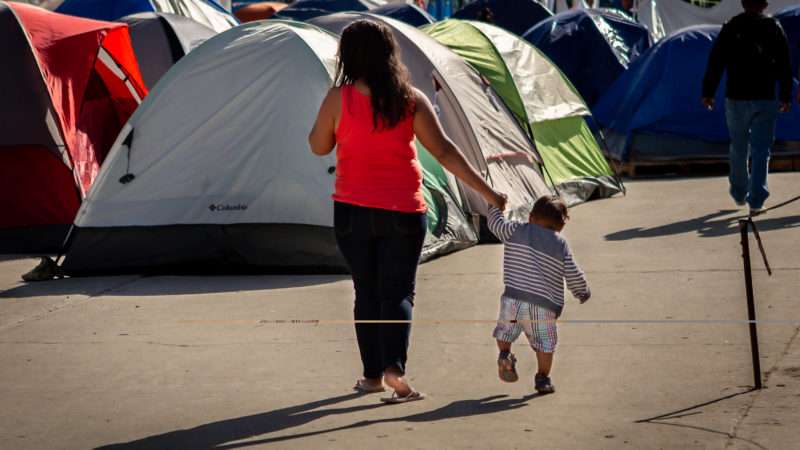
Each fall, at the direction of the Refugee Act of 1980, the president issues a determination setting a cap on the number of refugees who may be admitted to the United States for the next fiscal year. The first year, the cap was 231,700, though 207,116 refugees were actually admitted. The limit plunged dramatically over the next three years, rose again during George H.W. Bush’s administration, and hovered between 70,000 and 91,000 in the two decades between 1996 and when President Donald Trump took office. The Obama administration’s cap for 2017 was 110,000, but Trump lowered it to 50,000. For 2018, he dropped it to 45,000, then 30,000 the next year. The 2020 cap was just 18,000, and only half that number have been admitted, thanks in part to the administration’s pandemic immigration bans. For fiscal year 2021, will any refugees be admitted to America at all?
That’s an open question, because the deadline for Trump to issue his order is today, and an order has yet to appear. It could well arrive by midnight—last year’s cap was a last-minute affair—but it also may not arrive at all. Without a presidential determination, the cap will default to zero (a few special cases aside).
This is an arbitrary and cruel system both for refugees themselves and for the American refugee resettlement organizations trying to serve them. Trump should reverse his course toward eliminating refugee admissions altogether, setting the 2021 ceiling at 95,000, as requested by resettlement agencies this year and last year. More importantly, the entire approach to refugee admissions caps should be reformed so lives and organizational livelihoods no longer hang in the balance of presidential whim.
There are around 26 million refugees worldwide, people who, per the definition in that 1980 law, are “unable or unwilling to return to [their] country because of persecution or a well-founded fear of persecution based on race, religion, nationality, political opinion, or membership in a particular social group.” More than 100,000 are refugees already in the State Department’s backlog, many of them cleared for resettlement in the United States after extensive vetting (see some firsthand accounts of the multi-year admission process here) and hoping to reunite with family members already living here. If approved to travel here, they’d work with one of nine refugee resettlement agencies and their smaller partners, organizations with a local presence in the communities refugees will newly call home.
Instead, thanks to the administration’s pettiness and procrastination, all of this is in limbo. The risk here is not merely the short-term harm to the specific refugees awaiting admission, though certainly that is considerable. Many refugee camps are miserable places to live—muddy and overcrowded, rife with communicable illness (even before COVID-19), and sorely lacking the stability children, who are nearly half of the refugee population worldwide, need to learn and grow as they ought.
But there’s a long-term risk here, too, a way in which this administration’s caps could hurt refugees for decades after Trump has left the White House: The paucity of admissions is strangling resettlement and support groups. If the cap is very low again for 2021, it “very well could be the last, final blow to [Church World Service, one of the nine big agencies], as we’ve been treading water the last few years,” Jen Smyers, the group’s director of policy and advocacy for its immigration and refugee program, told CNN this week. “If there’s a whole month without resettlement, that alone is really detrimental to the program.” These organizations simply can’t stay afloat forever if Washington won’t let them do their work, and if they shut down entirely, the loss of institutional infrastructure and knowledge will not easily be replicated once the cap is raised again.
The government will always be involved in refugee admissions because it controls the border, but surely this process of determining an annual ceiling could be less erratic and more humane than the presidential determination system we have now. Instead of leaving the cap to executive discretion, the State Department could calculate it based on the nine agencies’ self-reported resettlement capacity. If each can handle an average of 20,000 refugees in one year, for example, set the cap at 180,000. If the average is 15,000 or 25,000 each the next year, lower or raise the total accordingly. These agencies will know their own business better than the president or any other federal bureaucrat.
This system, or something like it, would create far more predictability for the government, these charitable organizations, and the vulnerable people they seek to aid. There’d be no question of the determination deadline being met, as there is now, because it would be in the agencies’ interest to provide a prompt and accurate capacity report to maintain their relationship with the State Department.
As the process stands, the uncertainty foisted upon refugees and the Americans who want to support them is unacceptable and unnecessary. It isn’t helping Americans, and it’s actively hurting some of the world’s most vulnerable people—people who, in many cases, are refugees in whole or part because of destructive U.S. foreign policy. The least we can do is offer them a safe place to rebuild the lives our government helped destroy.
from Latest – Reason.com https://ift.tt/34eJq6v
via IFTTT